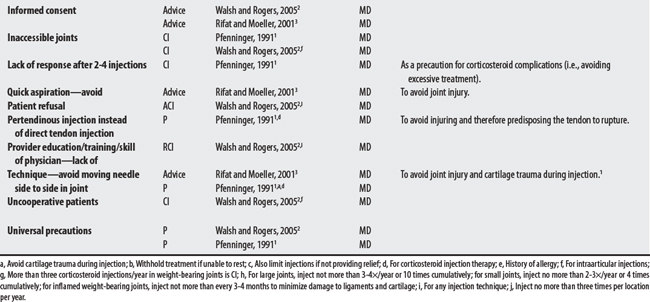Chapter 62 Injection Therapy
OVERVIEW.
Joint and soft tissue injection may be administered to differentially diagnose (i.e., identify the pain source), treat soft tissue pain, reduce inflammation (e.g., corticosteroid injections), or assist in the physical therapy of inflamed joints.1 Three sources (all physicians) mentioned 39 concerns for injection therapy. Concerns ranged from 10 to 31; many are corticosteroid related. The largest proportion of concerns was procedural (e.g., excessive cortisone treatments, poor technique) or musculoskeletal (e.g., some arthritic conditions). The most frequently cited injection therapy concerns were septicemia, coagulation defects, local infection, dosage restrictions with corticosteroids, and the need for aseptic technique.
CONTRAINDICATIONS AND PRECAUTIONS
INJECTION PROCEDURES (ANY)
A00-B99 CERTAIN INFECTIONS AND PARASITIC DISEASES
D50-D89 DISEASES OF BLOOD AND BLOOD-FORMING ORGANS AND CERTAIN DISORDERS
E00-E90 ENDOCRINE, NUTRITIONAL AND METABOLIC DISEASES
G00-G99 NEUROLOGICAL CONCERNS (EPIDURAL PROCEDURES)
I00-I99 DISEASES OF THE CIRCULATORY SYSTEM
L00-L99 DISEASES OF THE SKIN AND SUBCUTANEOUS TISSUE
M00-M99 DISEASES OF THE MUSCULOSKELETAL SYSTEM AND CONNECTIVE TISSUE
S00-T98 INJURY, POISONING, AND CERTAIN OTHER CONSEQUENCES OF EXTERNAL CAUSES
1 Pfenninger JL. Injection of joints and soft tissue: part I, general guidelines. Am Fam Phys. 1991;44(4):1196-1202.
2 Walsh NE, Rogers JN. Injection procedures. Delisa JA, editor. Physical medicine and rehabilitation: principles and practice, ed 4, vol 1. Philadelphia: Lippincott Williams & Wilkins, 2005.
3 Rifat SF, Moeller JL. Basics of joint injection: general techniques and tips for safe, effective use. Postgrad Med. 2001;109(1):157.




















